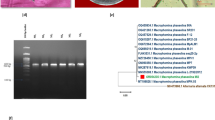Abstract
The production of indole-3-acetic acid (IAA), by rhizobacteria, has been associated with plant growth promotion, especially root initiation and elongation. Isolate TO3 selected from 103 fluorescent pseudomonads, identified as Pseudomonas aeruginosa, showed maximum production of IAA. Isolate TO3 having biocontrol activity against Macrophomina phaseolina also showed production of siderophore and HCN was used to screen the role of bacterial IAA in reducing the level of charcoal rot disease occurrence in chickpea. Four IAA defective stable mutants of isolate TO3 having biocontrol activity against M. phaseolina were developed through 5-bromouracil mutagenesis. Mutant TO52 showed 76.47% reduction in production of IAA. Standard IAA was used in similar concentration as present in cell-free culture supernatant of wild isolate TO3 and its mutant TO52. The in vitro and in vivo study showed that IAA-defective mutant TO52 caused reduced biocontrol and plant growth promotory activity than wild isolate TO3. Standard IAA showed comparable biocontrol activity to the culture supernatant. To some extent better biocontrol and growth promotory activity in supernatant than standard IAA indicates the synergistic role of siderophore and HCN. The study clearly reports the role of bacterial IAA in suppression of charcoal rot disease of chickpea.

Similar content being viewed by others
References
Altschul SF, Gish W, Miller W, Meyers EW, Lipman DJ (1990) Basic local alignment search tool. J Mol Biol 215:403–410
Arora NK, Khare E, Verma A, Sahu RK (2008) In vivo control of Macrophomina phaseolina by a chitinase and β-1,3-glucanase producing pseudomonad NDN1. Symbiosis 46:129–135
Arshad M, Frankenberger WT (1998) Plant growth-regulating substances in the rhizosphere: microbial production and functions. Adv Agron 62:34–151
Barazani O, Friedman J (1999) Is IAA the major root growth factor secreted from plant-growth-mediating bacteria? J Chem Ecol 25(10):2397–2406
Bhattacharya D, Basu S, Chattapadhyay JP, Bose SK (1985) Biocontrol of Macrophomina root rot disease of jute by an antagonistic organism Aspergillus versicolor. Plant Soil 87:435–438
Bric JM, Bostock RM, Silversone SE (1991) Rapid in situ assay for indoleacetic acid production by bacteria immobilization on a nitrocellulose membrane. Appl Environ Microbiol 57:535–538
Engelke TH, Jagadish MN, Puhler A (1987) Biochemical and genetical analysis of R. meliloti mutants defective in C4-dicarboxylate transport. J Gen Microbiol 133:3019–3029
Garrity G (2005) Bergey’s manual of systematic bacteriology. In: Brenner DJ, Krieg NR, Staley JT (eds) The proteobacteria, Part B. The gammaproteobacteria, vol 2, 2nd edn. Springer Science+Business Media, New York, NY, pp 323–379
Gerhardson B, Wright S (2002) Bacterial associations with plants: beneficial, non-N-fixing interactions. In: Sivasithamparam K, Dixon KW, Narrett RL (eds) Microorganism in plant conservation and biodiversity. Kluwer Academic Press, London, pp 79–103
Gravel V, Antoun H, Tweddell R (2007) Growth stimulation and fruit yield improvement of greenhouse tomato plants by inoculation with Pseudomonas putida or Trichoderma atroviride: possible role of indole acetic acid (IAA). Soil Biol Biochem 39:1968–1977
Gupta CP, Kumar B, Dubey RC, Maheshwari DK (2006) Chitinase-mediated destructive antagonistic potential of Pseudomonas aeruginosa GRC1 against Sclerotina sclerotiorum causing stem rot of peanut. Biocontrol 51:821–835
Gurusiddaiah S, Weller DM, Sarkar A, Cook RJ (1986) Characterization of antibiotic produced by a strain of Pseudomonas fluorescens inhibitory to Gaeumannomyces graminis var tritici and Pythium spp. Antimicrob Agents Chemother 29:488–495
Kloepper JW, Ryu CM (2006) Bacterial endophytes as elicitors of induced systemic resistance. In: Schulz B, Boyle C, Sieber TN (eds) Soil biology, microbial root endophytes, vol 9. Springer-Verlag, Berlin, pp 33–52
Loper JE, Henkels MD (1997) Availability of iron to Pseudomonas fluorescens in rhizosphere and bulk soil evaluated with an ice nucleation reporter gene. Appl Environ Microbiol 63:99–105
Maidak BL, Olsen GL, Larsen N, Overbeek R, McCaughey MJ, Woese CR (1997) The ribosomal database project. Nucleic Acids Res 24:82–85
Maidak BL, Cole JR, Lilburn TG, Parker CT, Saxman PR, Stredwick JM, Garrity GM, Li B, Olsen GJ, Pramanik S, Schmidt TM, Tiedje JM (2000) The RDP (ribosomal database project) continues. Nucleic Acids Res 28:173–174
Meyer JM, Abdallah MA (1978) The fluorescent pigment of Pseudomonas fluorescens. Biosynthesis, purification and physicochemical properties. J Gen Microbiol 107:319–328
Miller RL, Higgins VJ (1970) Association of cyanide with infection of birdspot trefoil by Stemphylium loti. Phytopathol 60:104–110
Patten CL, Glick BR (2002) Role of Pseudomonas putida indoleacetic acid in development of the host plant root system. Appl Environ Microbiol 68:3795–3801
Schwyn B, Neilands JB (1987) Universal chemical assay for the detection and determination of siderophores. Anal Biochem 160:47–56
Tanimoto E (2005) Regulation of root growth by plant hormones—roles for auxin and gibberellin. Cri Rev Plant Sci 24:249–265
Validov S, Kamilova F, Qi S, Stephan D, Wang JJ, Makarova N, Lugtenberg B (2007) Selection of bacteria able to control Fusarium oxysporum f. sp. radicis-lycopersici in stonewool substrate. J Appl Microbiol 102:461–471
Vessey JK (2003) Plant growth promoting rhizobacteria as biofertilizers. Plant Soil 255:571–586
Voisard C, Keel C, Haas D, Défago G (1989) Cyanide production by Pseudomonas fluorescens helps suppress black root rot of tobacco under gnotobiotic conditions. EMBO J 8:351–358
Xie H, Pasternak JJ, Glick BR (1996) Isolation and characterization of mutants of the plant growth-promoting rhizobacteria Pseudomonas putida GR12–2 that overproduce indoleacetic acid. Curr Microbiol 32:67–71
Acknowledgments
Thanks are due to Department of Biotechnology, New Delhi for the financial support for the study. E.K. is thankful to Council of Scientific and Industrial Research, New Delhi. The authors are grateful to Vice Chancellor, Chhatrapati Shahu Ji Maharaj University, Kanpur, India, for providing facilities and support.
Author information
Authors and Affiliations
Corresponding author
Rights and permissions
About this article
Cite this article
Khare, E., Arora, N.K. Effect of Indole-3-Acetic Acid (IAA) Produced by Pseudomonas aeruginosa in Suppression of Charcoal Rot Disease of Chickpea. Curr Microbiol 61, 64–68 (2010). https://doi.org/10.1007/s00284-009-9577-6
Received:
Accepted:
Published:
Issue Date:
DOI: https://doi.org/10.1007/s00284-009-9577-6




